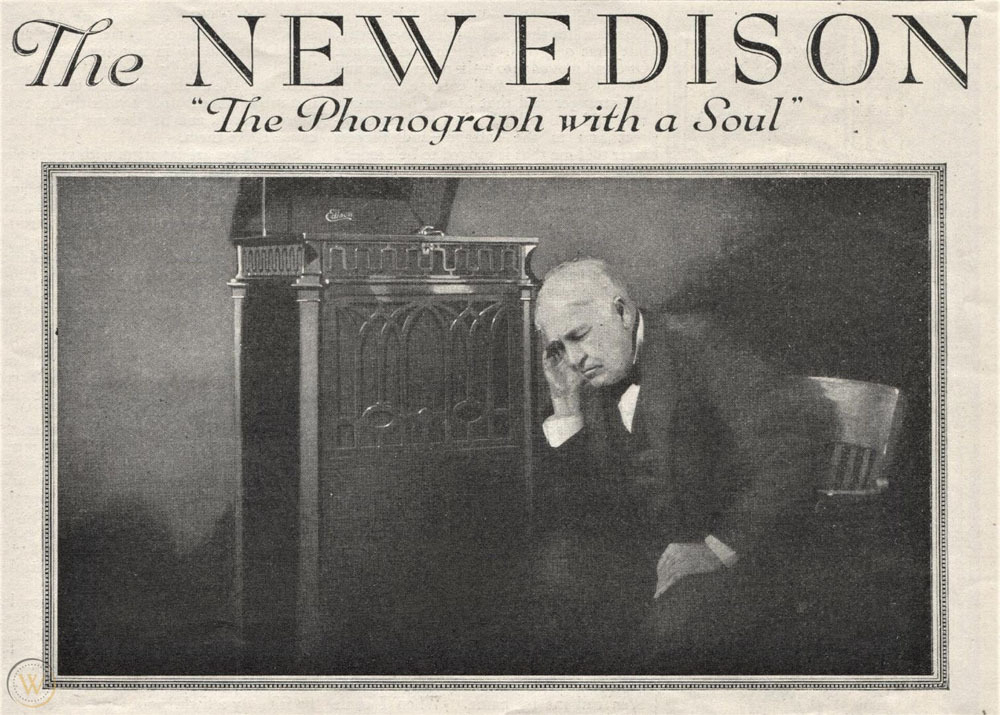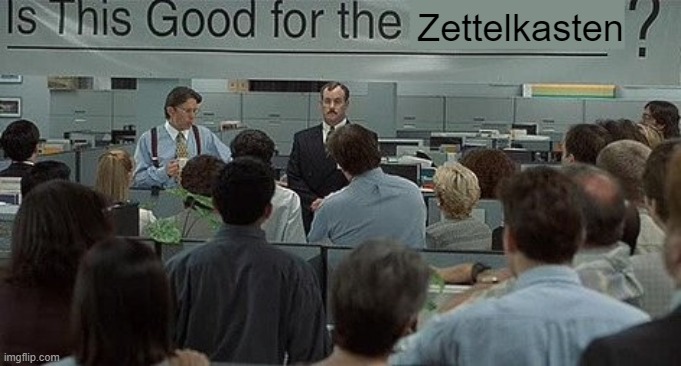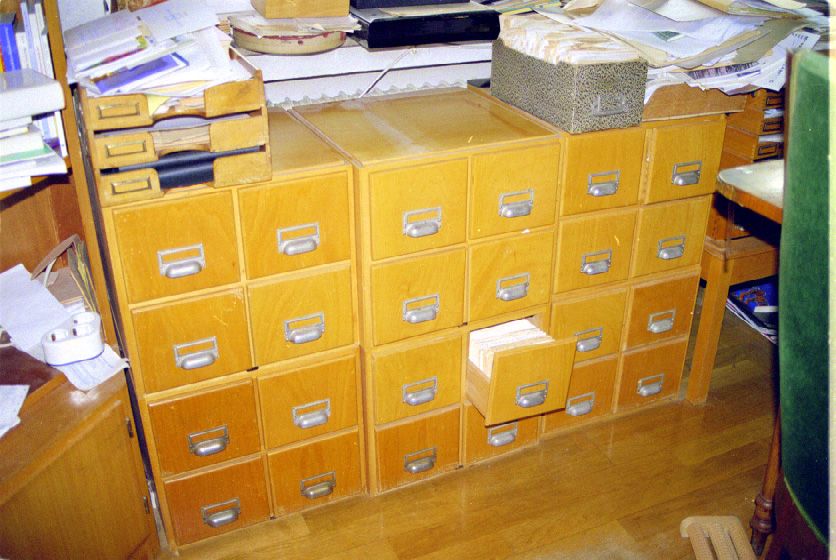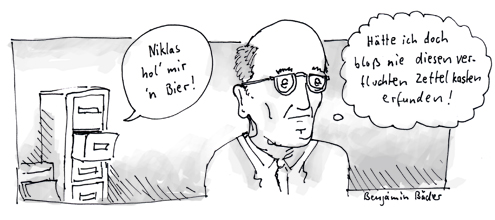Thoughts on Zettelkasten numbering systems
I've seen variations of the beginner Zettelkasten question:
"What happens when you want to add a new note between notes 1/1 and 1/1a?"
asked at least a dozen times in the Reddit fora related to note taking and zettelkasten, on zettelkasten.de, or in other places across the web.
Dense Sets
From a mathematical perspective, these numbering or alpha-numeric systems are, by both intent and design, underpinned by the mathematical idea of dense sets. In the areas of topology and real analysis, one considers a set dense when one can choose a point as close as one likes to any other point. For both library cataloging systems and numbering schemes for ideas in Zettelkasten this means that you can always juxtapose one topic or idea in between any other two.
Part of the beauty of Melvil Dewey's original Dewey Decimal System is that regardless of how many new topics and subtopics one wants to add to their system, one can always fit another new topic between existing ones ad infinitum.
Going back to the motivating question above, the equivalent question mathematically is "what number is between 0.11 and 0.111?" (Here we've converted the artificial "number" "a" to a 1 and removed the punctuation, which doesn't create any issues and may help clarify the orderings a bit.) The answer is that there is an infinite number of numbers between these!
This is much more explicit by writing these numbers as:<br />
0.110<br />
0.111
Naturally 0.1101 is between them (along with an infinity of others), so one could start here as a means of inserting ideas this way if they liked. One either needs to count up sequentially (0, 1, 2, 3, ...) or add additional place values.
Decimal numbering systems in practice
The problem most people face is that they're not thinking of these numbers as decimals, but as natural numbers or integers (or broadly numbers without any decimal portions). Though of course in the realm of real numbers, numbers above 0 are dense as well, but require the use of their decimal portions to remain so.
The tough question is: what sorts of semantic meanings one might attach to their adding of additional place values or their alphabetical characters? This meaning can vary from person to person and system to system, so I won't delve into it here.
One may find it useful to logically chunk these numbers into groups of three as is often done using commas, periods, slashes, dashes, spaces, or other punctuation. This doesn't need to mean anything in particular, but may help to make one's numbers more easily readable as well as usable for filing new ideas. Sometimes these indicators can be confusing in discussion, so if ever in doubt, simply remove them and the general principles mentioned here should still hold.
Depending on one's note taking system, however, when putting cards into some semblance of a logical sort-able order (perhaps within a folder for example), the system may choke on additional characters beyond the standard period to designate a decimal number. For example: within Obsidian, if you have a "zettelkasten" folder with lots of numbered and named files within it, you'll want to give each number the maximum number of decimal places so that when doing an alphabetic sort within the folder, all of the numbered ideas are properly sorted. As an example if you give one file the name "0.510 Mathematics", another "0.514 Topology" and a third "0.5141 Dense Sets" they may not sort properly unless you give the first two decimal expansions to the ten-thousands place at a minimum. If you changed them to "0.5100 Mathematics" and "0.5140 Topology, then you're in good shape and the folder will alphabetically sort as you'd expect. Similarly some systems may or may not do well with including alphabetic characters mixed in with numbers.
If using chunked groups of three numbers, one might consider using the number 0.110.001 as the next level of idea between them and then continuing from there. This may help to spread some of the ideas out as surely one may have yet another idea to wedge in between 0.110.000 and 0.110.001?
One can naturally choose almost any any (decimal) number, so long as it it somewhat "near" the original behind which one places it. By going out further in the decimal expansion, one can always place any idea between two others and know that there will be a number that it can be given that will "work".
Generally within numbers as we use them for mathematics, 0.100000001 is technically "closer" by distance measurement to 0.1 than 0.11, (and by quite a bit!) but somehow when using numbers for zettelkasten purposes, we tend to want to not consider them as decimals, as the Dewey Decimal System does. We also have the tendency to want to keep our numbers as short as possible when writing, so it seems more "natural" to follow 0.11 with 0.111, as it seems like we're "counting up" rather than "counting down".
Another subtlety that one sees in numbering systems is the proper or improper use of the whole numbers in front of the decimal portions. For example, in Niklas Luhmann's system, he has a section of cards that start with 3.XXXX which are close to a section numbered 35.YYYY. This may seem a bit confusing, but he's doing a bit of mental gymnastics to artificially keep his numbers smaller. What he really means is 3000.XXX and 3500.YYY respectively, he's just truncating the extra zeros. Alternately in a fully "decimal system" one would write these as 0.3000.XXXX and 0.3500.YYYY, where we've added additional periods to the numbers to make them easier to read. Using our original example in an analog system, the user may have been using foreshortened indicators for their system and by writing 1/1a, they may have really meant something of the form 001.001/00a, but were making the number shorter in a logical manner (at least to them).
The close observer may have seen Scott Scheper adopt the slightly longer numbers in the thousands (like 3500.YYYY) as a means of remedying some of the numbering confusion many have when looking at Luhmann's system.
Those who build their systems on top of existing ones like the Dewey Decimal Classification, or the Universal Decimal Classification may wish to keep those broad categories with three to four decimal places at the start and then add their own idea number underneath those levels.
As an example, we can use the numbering for Finsler geometry from the Dewey Decimal Classification wikipedia page shown as:
```
500 Natural sciences and mathematics
510 Mathematics
516 Geometry
516.3 Analytic geometries
516.37 Metric differential geometries
516.375 Finsler geometry
```
So in our zettelkasten, we might add our first card on the topic of Finsler geometry as "516.375.001 Definition of Finsler geometry" and continue from there with some interesting theorems and proofs on those topics.
Of course, while this is something one can do doesn't mean that one should do it. Going too far down the rabbit holes of "official" forms of classification this way can be a massive time wasting exercise as in most private systems, you're never going to be comparing your individual ideas with the private zettelkasten of others and in practice the sort of standardizing work for classification this way is utterly useless. Beyond this, most personal zettelkasten are unique and idiosyncratic to the user, so for example, my math section labeled 510 may have a lot more overlap with history, anthropology, and sociology hiding within it compared with others who may have all of their mathematics hiding amidst their social sciences section starting with the number 300. One of the benefits of Luhmann's numbering scheme, at least for him, is that it allowed his system to be much more interdisciplinary than using a more complicated Dewey Decimal oriented system which may have dictated moving some of his systems theory work out of his politics area where it may have made more sense to him in addition to being more productive on a personal level.
Of course if you're using the older sort of commonplacing zettelkasten system that was widely in use before Luhmann's variation, then perhaps using a Dewey-based system may be helpful to you?
A Touch of History
As both a mathematician working in the early days of real analysis and a librarian, some of these loose ideas may have occurred tangentially to Gottfried Wilhelm Leibniz (1646 - 1716), though I'm currently unaware of any specific instances within his work. One must note, however, that some of the earliest work within library card catalogs as we know and use them today stemmed from 1770s Austria where governmental conscription needs overlapped with card cataloging systems (Krajewski, 2011). It's here that the beginnings of these sorts of numbering systems begin to come into use well before Melvil Dewey's later work which became much more broadly adopted.
The German "file number" (aktenzeichen) is a unique identification of a file, commonly used in their court system and predecessors as well as file numbers in public administration since at least 1934. We know Niklas Luhmann studied law at the University of Freiburg from 1946 to 1949, when he obtained a law degree, before beginning a career in Lüneburg's public administration where he stayed in civil service until 1962. Given this fact, it's very likely that Luhmann had in-depth experience with these sorts of file numbers as location identifiers for files and documents. As a result it's reasonably likely that a simplified version of these were at least part of the inspiration for his own numbering system. † ‡
Your own practice
At the end of the day, the numbering system you choose needs to work for you within the system you're using (analog, digital, other). I would generally recommend against using someone else's numbering system unless it completely makes sense to you and you're able to quickly and simply add cards to your system with out the extra work and cognitive dissonance about what number you should give it. The more you simplify these small things, the easier and happier you'll be with your set up in the end.
References
Krajewski, Markus. Paper Machines: About Cards & Catalogs, 1548-1929. Translated by Peter Krapp. History and Foundations of Information Science. MIT Press, 2011. https://mitpress.mit.edu/books/paper-machines.
Munkres, James R. Topology. 2nd ed. 1975. Reprint, Prentice-Hall, Inc., 1999.



 Luhmann zuhause am Zettelkasten (vermutlich Ende der 1970er/Anfang 1980er Jahre)<br />
Copyright Michael Wiegert-Wegener<br />
via
Luhmann zuhause am Zettelkasten (vermutlich Ende der 1970er/Anfang 1980er Jahre)<br />
Copyright Michael Wiegert-Wegener<br />
via  (via
(via 
